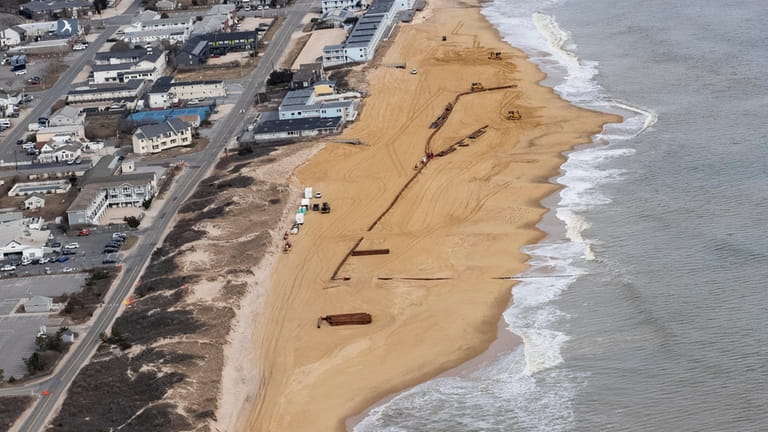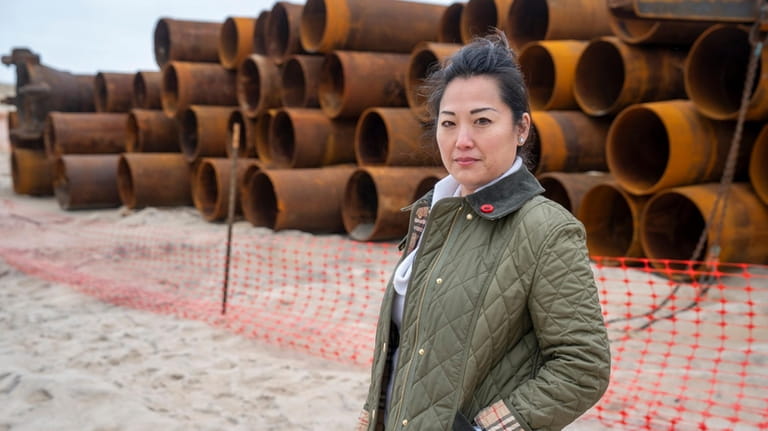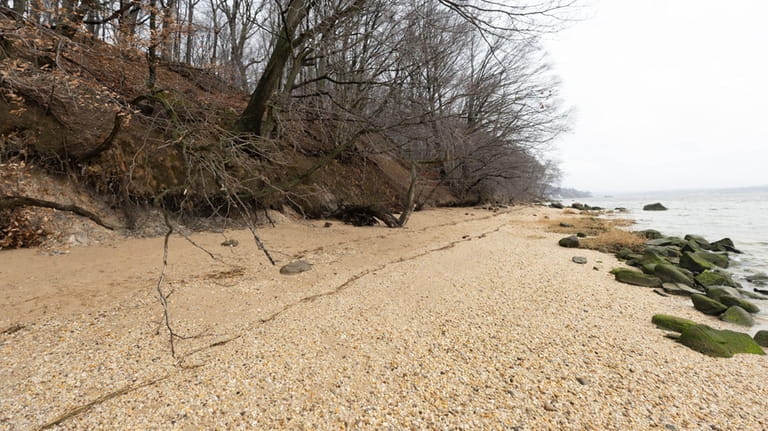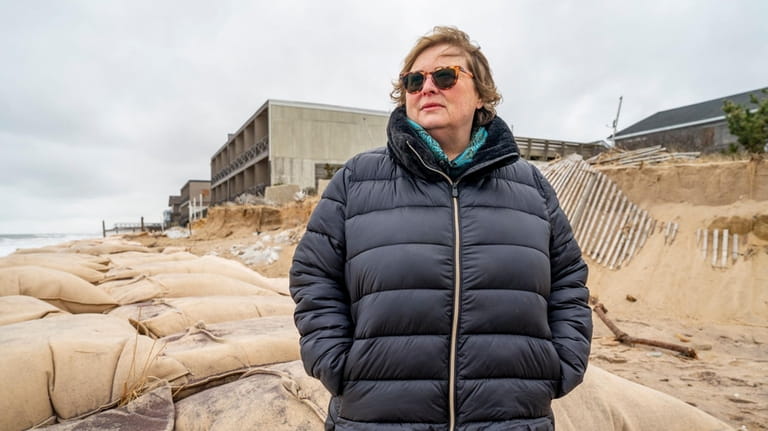Long Island's storm-battered beaches raise questions of how to deal with erosion

On the bluffs at Garvies Point Preserve, overlooking Hempstead Harbor, the sandy soil has washed away from the roots of trees that cling to the steep slope, their poorly anchored trunks leaning precariously toward the beach. Even on a windless day in February, the bluff was shifting almost imperceptibly, as a bit of sand and a few pebbles slipped down the face of the bluff and came to rest on the beach.
As the seas rise and altered weather patterns bring more frequent and intense storms, Long Island's shores are getting heavily battered. In three storms in December and January, heavy waves and rainfall scraped away the foundations of the North Shore’s iconic bluffs and swept sand from the South Shore's wide beaches. Many Long Islanders reported the winter storms brought "the most dramatic beach erosion that they've seen," said Alison Branco, climate adaptation director at The Nature Conservancy in New York.
In the wake of the storms, Newsday set out to chronicle the damage, and to talk to experts and local residents about their expectations for the future if such trends continue.
The most alarming erosion caused by the storms — on Dec. 18, Jan. 9-10 and Jan. 12 — was on South Shore beaches, including at state parks such as Gilgo Beach and Hither Hills, and on Fire Island. Damage estimates are still being calculated. In late January, Gov. Kathy Hochul pledged $5 million to repair structures on Overlook Beach in Babylon and for eroded beaches in Fire Island Pines and Cherry Grove.
Many more communities are asking for help from the state or the federal government, but there's no guarantee their projects will be funded.
Ditch Plains Beach in Montauk is one that residents and the local government are hoping can be restored. Until this winter, it was several hundred feet wide at high tide. Now the water reaches within about 100 feet of the dune, even when the tide is out. Storm surge in January overtopped the dunes, ripping the porch from one shingled house. The small dune the owner had built to protect the property has disappeared.
“Sand does get redeposited seasonally, but we’ve never seen anything like this,” said Kay Tyler, of Concerned Citizens of Montauk, a year-round resident of Montauk for 12 years. “A lot of it won’t come back.”
The town has asked the state for funds to restore Ditch Plains Beach, which was not included in the federally funded U.S. Army Corps of Engineers sand project recently completed at Montauk’s Main Beach, at a cost of $11.2 million. Excluding Ditch Plains “was a huge oversight,” Tyler said, “because Ditch is a destination for Montauk. Anyone who knows Montauk knows Ditch Beach, for the surfing, for the scene — it’s the coolest spot.”
Replacing sand is the government's most immediate solution for erosion, but it can cost millions and is a temporary fix. The Corps assumes most of its sand projects will last four or five years before more sand needs to be dredged and pumped again, according to James D’Ambrosio, a spokesperson for the Corps.
Some projects are disappearing much faster. Two years ago, the Corps pumped sand on Gilgo Beach in Babylon, but the beach was heavily eroded again this winter. On a gray day in late February, Billy, a Deer Park resident who declined to give his last name for privacy reasons, zipped his jacket against the wind as he headed out for a walk on Babylon's Cedar Beach. He said he has lived in the area most of his life and has witnessed severe erosion in recent years. Sore Thumb Beach, about a mile east, was once his favorite fishing spot, but it became so depleted that he switched to Gilgo Beach. But Gilgo, too, is shrinking, he said. "Every year it gets smaller and smaller."
Half a mile down the shore, the road leading to Overlook Beach was blocked by a metal gate with a sign: "Overlook Beach closed due to erosion."
Erosion now affects nearly half of East Hampton’s 60 miles of bay and coastal shorelines, according to the town’s 2021 Coastal Assessment and Resiliency Plan, a blueprint for addressing rising sea levels. The plan identified erosion as its first priority among the many problems caused by sea level rise. But the town considers sand replenishment “an interim measure approximately limited to the next 15 years,” while officials work on longer-term climate adaptation strategies.
While Tyler favors the beach replenishment projects, her organization is also advocating for more far-sighted solutions. The winter storms, she said, have shaken the community.
“It’s a wakeup call to a lot of people that live here, to think about what their options are in terms of moving back or moving up,” Tyler said.
Erosion is a natural process, but human-built developments have hastened it by removing the Island’s natural defenses and weakening its geological structures. On the North Shore, houses, pools and decks perched above the Sound weigh down the bluffs and make them more susceptible to erosion and eventually to collapse. Homeowners have razed native plants whose deep roots stabilize the soil and absorb rain and replaced them with a monoculture of shallow-rooted, overwatered lawn. Once the healthy tangle of grasses and shrubs are gone, storm water — and excess sprinkler water — spill over the edge of the cliff, bringing the loosened soil with it.
Sediment that once flowed to the ocean and replenished beaches along the East Coast has been blocked by thousands of mill dams built on rivers and streams in the 19th century, many of them now defunct but still causing ecological damage.
Salt marshes that temper the force of storms have been drained and filled in for development and strangled by pollutants. And dunes that buffered storm surges have been leveled to make way for properties perched close to the water, including Montauk’s famous motels.
When the motels were built in the 1950s and '60s, “I don’t know that there was an awareness of the dunes as a primary defense," East Hampton Deputy Supervisor Cate Rogers said as she surveyed the damage in late January. Today, many of Montauk's remaining rolling dunes have been scoured into steep escarpments. On South Edison Beach, a row of wooden staircases leading down toward the water stop well short of the solid ground: The bottom steps have been torn away and the sand beneath swept out to sea.
For many years, the solution to protecting human structures from erosion has been to build more hard structures — sea walls, breakwaters, groins, bulkheads — to keep the waves from pounding the shore. These strategies can be effective in defending a targeted stretch of beach, but they don’t really prevent erosion — they displace it.
Erosion “sort of works like a conveyor belt,” Branco said. “The sand should just make its way all along the shoreline. Every time we interrupt that by hardening, we're just robbing the sand from somebody else downshore.”
When a jetty at West End 2 in Jones Beach was extended some 20 years ago, the beach at Point Lookout across the Jones Inlet "just eroded away," recalls Dave Juan, the owner of the unsOund surf shop in Long Beach, where he has lived since he was a child. "When I was a kid, it was the biggest beach," Juan said. But after the jetty extension, "you saw Point Lookout disappear."
Armoring the shore also “gives people this false sense of security, so they wind up building behind the walls even more,” Branco said. “And then at some point the wall will fail, or it will be overtopped."
“The water is going to rise, and absolutely nothing we build is going to stop that,” she said.
Most experts now advocate “nature-based” solutions, such as rebuilding dunes flattened by developers, strengthening bluffs with tough native plants and restoring shellfish reefs, seagrass meadows and salt marsh. Some Long Island marshes have been restored in recent years, including in Wertheim, Lido Beach and Seatuck national wildlife refuges.
Similarly, nature-based solutions for eroding bluffs are focused on re-establishing native plants, whose roots knit the loose soil together, sometimes aided by eco-engineered inventions. Sarah Schaefer-Brown, a sustainable and resilient communities specialist with New York Sea Grant, said these solutions are a more promising approach in times of rapid climate change, because they “allow shoreline to be flexible and adaptive instead of trying to control the site.”
In the coming decades, though, the rising seas will begin to outpace even the most sensible and effective nature-based solutions. Already at Garvies Point Preserve, one of the trails leading down to the water is closed; the wooden steps once set into the eroded hillside have broken loose and tumbled toward the beach below. Down at the shoreline, a sign warns visitors to "please stay off the cliffs": Scrambling on the unstable slope will disturb the soil and worsen erosion.
On the bluffs at Garvies Point Preserve, overlooking Hempstead Harbor, the sandy soil has washed away from the roots of trees that cling to the steep slope, their poorly anchored trunks leaning precariously toward the beach. Even on a windless day in February, the bluff was shifting almost imperceptibly, as a bit of sand and a few pebbles slipped down the face of the bluff and came to rest on the beach.
As the seas rise and altered weather patterns bring more frequent and intense storms, Long Island's shores are getting heavily battered. In three storms in December and January, heavy waves and rainfall scraped away the foundations of the North Shore’s iconic bluffs and swept sand from the South Shore's wide beaches. Many Long Islanders reported the winter storms brought "the most dramatic beach erosion that they've seen," said Alison Branco, climate adaptation director at The Nature Conservancy in New York.
In the wake of the storms, Newsday set out to chronicle the damage, and to talk to experts and local residents about their expectations for the future if such trends continue.

Sand restoration takes place on Montauk beaches in February. Credit: Doug Kuntz
Replenishing stripped beaches
The most alarming erosion caused by the storms — on Dec. 18, Jan. 9-10 and Jan. 12 — was on South Shore beaches, including at state parks such as Gilgo Beach and Hither Hills, and on Fire Island. Damage estimates are still being calculated. In late January, Gov. Kathy Hochul pledged $5 million to repair structures on Overlook Beach in Babylon and for eroded beaches in Fire Island Pines and Cherry Grove.
WHAT TO KNOW
- As the seas rise and altered weather patterns bring more frequent and intense storms, Long Island's shores are getting heavily battered, raising questions of how to deal with continued coastal erosion.
- In three storms in December and January, heavy waves and rainfall scraped away the foundations of the North Shore’s iconic bluffs. The most alarming damage was on South Shore beaches, including at state parks such as Gilgo Beach and Hither Hills, and on Fire Island.
- Replacing sand is the most immediate remedy, but it is a costly and temporary fix. Most experts advocate “nature-based” solutions, but say rising seas will begin to outpace even the most effective remedies.
Many more communities are asking for help from the state or the federal government, but there's no guarantee their projects will be funded.
Ditch Plains Beach in Montauk is one that residents and the local government are hoping can be restored. Until this winter, it was several hundred feet wide at high tide. Now the water reaches within about 100 feet of the dune, even when the tide is out. Storm surge in January overtopped the dunes, ripping the porch from one shingled house. The small dune the owner had built to protect the property has disappeared.
“Sand does get redeposited seasonally, but we’ve never seen anything like this,” said Kay Tyler, of Concerned Citizens of Montauk, a year-round resident of Montauk for 12 years. “A lot of it won’t come back.”

Kay Tyler, executive director of Concerned Citizens of Montauk, surveys erosion and storm damage at Kirk Park Beach in Montauk on Jan. 30. Credit: Randee Daddona
The town has asked the state for funds to restore Ditch Plains Beach, which was not included in the federally funded U.S. Army Corps of Engineers sand project recently completed at Montauk’s Main Beach, at a cost of $11.2 million. Excluding Ditch Plains “was a huge oversight,” Tyler said, “because Ditch is a destination for Montauk. Anyone who knows Montauk knows Ditch Beach, for the surfing, for the scene — it’s the coolest spot.”
Replacing sand is the government's most immediate solution for erosion, but it can cost millions and is a temporary fix. The Corps assumes most of its sand projects will last four or five years before more sand needs to be dredged and pumped again, according to James D’Ambrosio, a spokesperson for the Corps.
Some projects are disappearing much faster. Two years ago, the Corps pumped sand on Gilgo Beach in Babylon, but the beach was heavily eroded again this winter. On a gray day in late February, Billy, a Deer Park resident who declined to give his last name for privacy reasons, zipped his jacket against the wind as he headed out for a walk on Babylon's Cedar Beach. He said he has lived in the area most of his life and has witnessed severe erosion in recent years. Sore Thumb Beach, about a mile east, was once his favorite fishing spot, but it became so depleted that he switched to Gilgo Beach. But Gilgo, too, is shrinking, he said. "Every year it gets smaller and smaller."

Eroded bluffs at Garvies Point Preserve in Glen Cove on Feb. 28. Credit: Kendall Rodriguez
Half a mile down the shore, the road leading to Overlook Beach was blocked by a metal gate with a sign: "Overlook Beach closed due to erosion."
Erosion now affects nearly half of East Hampton’s 60 miles of bay and coastal shorelines, according to the town’s 2021 Coastal Assessment and Resiliency Plan, a blueprint for addressing rising sea levels. The plan identified erosion as its first priority among the many problems caused by sea level rise. But the town considers sand replenishment “an interim measure approximately limited to the next 15 years,” while officials work on longer-term climate adaptation strategies.
While Tyler favors the beach replenishment projects, her organization is also advocating for more far-sighted solutions. The winter storms, she said, have shaken the community.
“It’s a wakeup call to a lot of people that live here, to think about what their options are in terms of moving back or moving up,” Tyler said.
Holding back the sea
Erosion is a natural process, but human-built developments have hastened it by removing the Island’s natural defenses and weakening its geological structures. On the North Shore, houses, pools and decks perched above the Sound weigh down the bluffs and make them more susceptible to erosion and eventually to collapse. Homeowners have razed native plants whose deep roots stabilize the soil and absorb rain and replaced them with a monoculture of shallow-rooted, overwatered lawn. Once the healthy tangle of grasses and shrubs are gone, storm water — and excess sprinkler water — spill over the edge of the cliff, bringing the loosened soil with it.
Sediment that once flowed to the ocean and replenished beaches along the East Coast has been blocked by thousands of mill dams built on rivers and streams in the 19th century, many of them now defunct but still causing ecological damage.
Salt marshes that temper the force of storms have been drained and filled in for development and strangled by pollutants. And dunes that buffered storm surges have been leveled to make way for properties perched close to the water, including Montauk’s famous motels.
When the motels were built in the 1950s and '60s, “I don’t know that there was an awareness of the dunes as a primary defense," East Hampton Deputy Supervisor Cate Rogers said as she surveyed the damage in late January. Today, many of Montauk's remaining rolling dunes have been scoured into steep escarpments. On South Edison Beach, a row of wooden staircases leading down toward the water stop well short of the solid ground: The bottom steps have been torn away and the sand beneath swept out to sea.

“I don’t know that there was an awareness of the dunes as a primary defense" when the Montauk motels were built, said East Hampton Deputy Supervisor Cate Rogers, shown at Montauk's South Edison Beach in late January. Credit: Randee Daddona
For many years, the solution to protecting human structures from erosion has been to build more hard structures — sea walls, breakwaters, groins, bulkheads — to keep the waves from pounding the shore. These strategies can be effective in defending a targeted stretch of beach, but they don’t really prevent erosion — they displace it.
Erosion “sort of works like a conveyor belt,” Branco said. “The sand should just make its way all along the shoreline. Every time we interrupt that by hardening, we're just robbing the sand from somebody else downshore.”
When a jetty at West End 2 in Jones Beach was extended some 20 years ago, the beach at Point Lookout across the Jones Inlet "just eroded away," recalls Dave Juan, the owner of the unsOund surf shop in Long Beach, where he has lived since he was a child. "When I was a kid, it was the biggest beach," Juan said. But after the jetty extension, "you saw Point Lookout disappear."
Armoring the shore also “gives people this false sense of security, so they wind up building behind the walls even more,” Branco said. “And then at some point the wall will fail, or it will be overtopped."
“The water is going to rise, and absolutely nothing we build is going to stop that,” she said.
Most experts now advocate “nature-based” solutions, such as rebuilding dunes flattened by developers, strengthening bluffs with tough native plants and restoring shellfish reefs, seagrass meadows and salt marsh. Some Long Island marshes have been restored in recent years, including in Wertheim, Lido Beach and Seatuck national wildlife refuges.
Similarly, nature-based solutions for eroding bluffs are focused on re-establishing native plants, whose roots knit the loose soil together, sometimes aided by eco-engineered inventions. Sarah Schaefer-Brown, a sustainable and resilient communities specialist with New York Sea Grant, said these solutions are a more promising approach in times of rapid climate change, because they “allow shoreline to be flexible and adaptive instead of trying to control the site.”
In the coming decades, though, the rising seas will begin to outpace even the most sensible and effective nature-based solutions. Already at Garvies Point Preserve, one of the trails leading down to the water is closed; the wooden steps once set into the eroded hillside have broken loose and tumbled toward the beach below. Down at the shoreline, a sign warns visitors to "please stay off the cliffs": Scrambling on the unstable slope will disturb the soil and worsen erosion.
